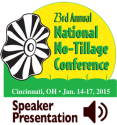Advertise Follow Us
Items Tagged with 'profitability'
ARTICLES
Farmer shows the advantages of using no-till on his farm
Read More
Yellow Field Peas Could Boost No-Till Profits In High Plains
Yellow field peas provide High Plains no-tillers with an excellent wheat transition crop that helps build soil quality and, with recent market developments, have the potential for profitability.
Read More
Variable Rate Technology Plants Seeds Of Profitability
Once they commit to the practice, no-tillers often find that managing planting populations on the go can cut seed costs and maximize yield.
Read More
Implement Guidance Paves The Way To Profitability
Technology that keeps field implements in line is gaining momentum as no-tillers and strip-tillers see increased yields, and lower input costs, through improved accuracy with field operations.
Read More
Matching Nitrogen Rates To Strip-Till Profitability
Through research, Minnesota strip-tiller David Legvold and college senior Emma Cornwell found the most profitable rate of sidedressed liquid 28% isn’t always the highest rate.
Read More
PRODUCTS
Ways To No-Till That Improve Yields & Profits While Protecting Natural Resources - Bret Margraf - NNTC 2015 Presentation - MP3 Download
$19.95
As a farmer, Bret Margraf understands the need to be a businessman and be profitable. As a nutrient management specialist for the Seneca County Conservation District, the no-tiller wants to balance profitability with protecting natural resources. The no-tiller will offer up the best techniques used on his McCutchenville, Ohio, farm where he no-tills corn, soybeans and wheat. View












